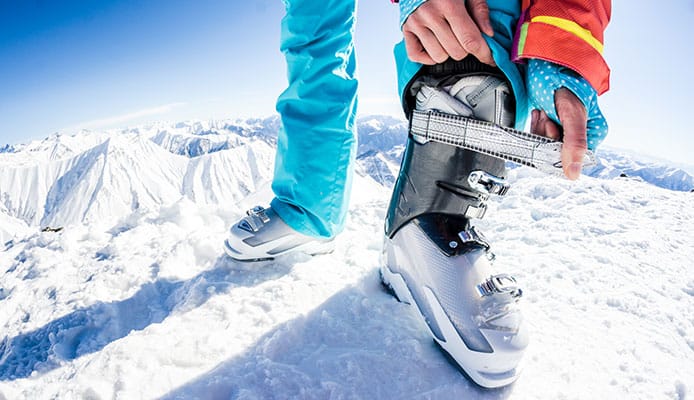Choosing the best ski boots for a beginner skier is crucial for having the best possible experience on the slopes. The moment you pick an ill-fitting boot, the wonderful feeling skiing gives you will be suddenly transformed into pain from your feet. You can get it wrong by choosing a ski boot that is better suited for skilled skiers too. By getting an intermediate or expert level ski boot, you will have a very hard time controlling the skis on the slopes. As a beginner skier, you will see hear tons of advice, information, and tips.
The number one piece of gear that will keep the first timers from sticking with skiing is an uncomfortable ski boot. Thankfully, there are many high-quality budget ski boots on the entry-level market. Most of the best beginner ski boots are based on more expensive models, but with a roomier fit and a softer forward flex. The following boots on this list are the top five best ski boots for beginners. Without further ado, let’s get to them:
OUR TOP PICK
Tecnica Ten HVL Ski Boots For Beginners
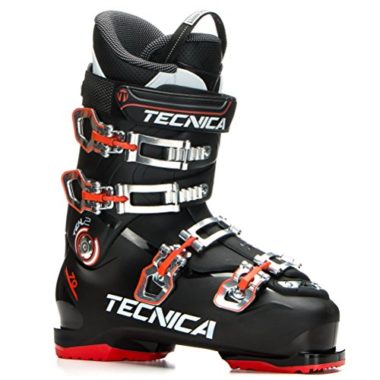
- What Makes These Beginner Ski Boots Stand Out
- One of the best beginner ski boots for wide feet
- Highly durable, guaranteed years of use even with a lot of wear & tear
- Good performance on any piste that a skier can find himself on
- Thick, warm and comfortable liner
- Guarantee a perfect fit for nearly all foot sizes
- Very versatile and adjustable
- Good flex rating for beginners
Weight: 13 pounds
Flex: 70
Last: 106
Sizes: 26.5, 27.5, 28.5, 29.5, and 30.5
Warranty: One Year
Buckle Count: 4
EDITORS CHOICE
Salomon QST Access 70 Ski Boots For Beginners
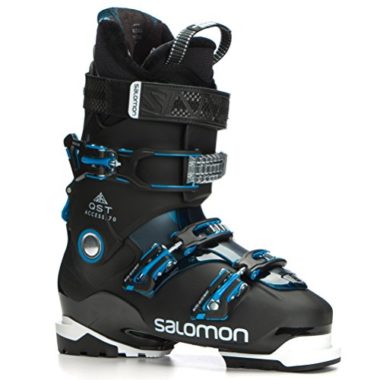
- What Makes These Beginner Ski Boots Stand Out
- Guarantee warmth even during the coldest days
- Made of comfortable material
- Prevent heat from escaping
- Very convenient and practical to use thank to the walk mode
- Easy to take on and off
- A great choice for skiers with large feet
Weight: 13 pounds
Flex: 70
Last: 100
Sizes: 26.5, 27.5, 28.5, 29.5, 30.5, and 31.5
Warranty: One Year
Buckle Count: 3
BEST VALUE
Salomon X Access 70 Ski Boots For Beginners
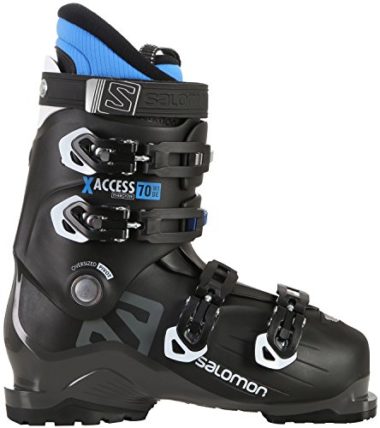
- What Makes These Beginner Ski Boots Stand Out
- A great choice for those with large feet
- One of the best cheap investments a beginner skier can make
- A low prize without compromised quality
- Comfortable and relaxed fit
- More than excellent value for the money
Weight: 13 pounds
Flex: 70
Last: 104|
Sizes: 26.5, 27.5, 28.5, 29.5, 30.5, and 31.5
Warranty: One Year
Buckle Count: 3
Nordica Sportmachine 65 Ski Boots For Beginners
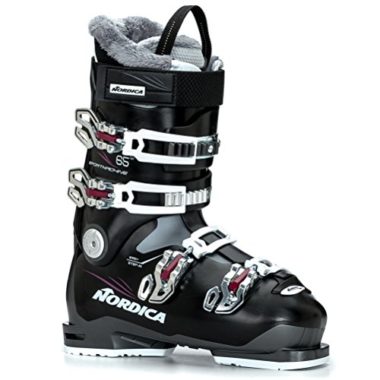
- What Makes These Beginner Ski Boots Stand Out
- Quite comfortable and relaxed fit
- Provide a high level of quality for the money
- Excellent for short runs and easy to use
- Firm & solid build
- One of the most stylish and trendy ski boots on the market
- Cushy and comfortable inside liner
Weight: 10 pounds
Flex: 65
Last: 102
Sizes: 26, and 26.5
Warranty: One Year
Buckle Count: 4
Salomon X-Pro 80 CS Ski Boots For Beginners
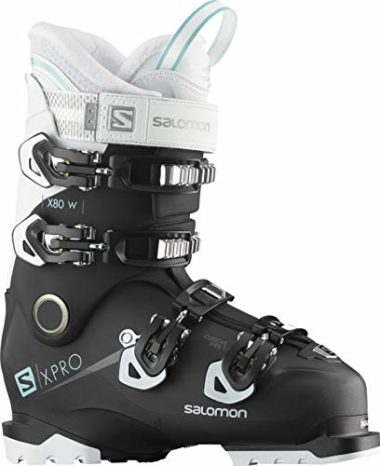
- What Makes These Beginner Ski Boots Stand Out
- Easy to progress with
- Very adjustable based on skill level and conditions
- Quite firm, yet comfortable fit
- Durable and resilient build
- Comfortable on the inside
- Suitable for a wide array of feet shapes and sizes
Weight: 13 pounds
Flex: 80
Last: 100
Sizes: 22.5, 23.5, 24.5, 25.5, 26.5, and 27.5
Warranty: One Year
Buckle Count: 3
How To Choose A Beginner Ski Boot – Buying Guide
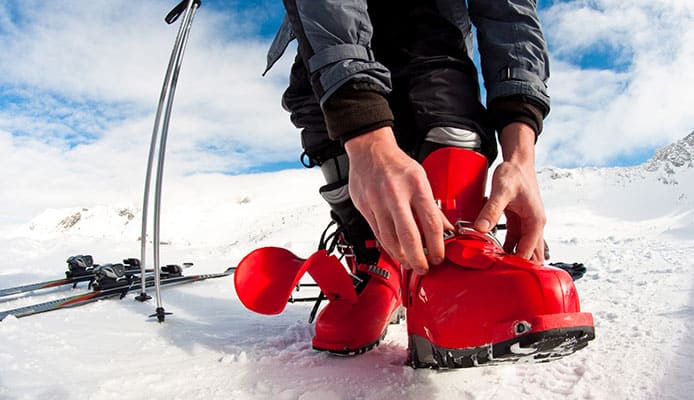
Picking a good pair of the best ski boots for beginners is crucial for a good skiing experience. If you pick a beginner ski boot that doesn’t fit properly, the awesomeness of skiing will be immediately gone.
In this following guide, you will learn everything you need to know about your first ski boots. There are a couple of critical factors that will impact your ski boot buying decisions. As a beginner, there is no need to find the “perfect” fit, but keep in mind that a poorly fitted ski boot or an uncomfortable one can slow down your learning progress and kill your fun on the slopes. That is why, by the end of this guide, you will know exactly what to look for in the pair of the perfect ski boots for you. We have broken down all of the information you should know before you purchase your ski boots for novices:
Related Post: Buy Ski Boots
Size
There is a special way how ski boots and sized. Both men’s and women’s ski boots are listed in unisex Mondo (also known as Mondo point) sizing. In simple terms, this is the length of your foot measured in centimeters. You can measure your foot by tracing its outline on a piece of paper or marking the bottom of the heel and the top of your toes. If your foot measures 30 centimeters in length, then your Mondo size is 30 – simple as that. Getting measured in a ski shop is how some skiers prefer to do it, but it is completely necessary since you can do all of that at home.
Related Review: Women Ski Boots
Every manufacturer or retailer always provides a sizing chart that will match shoe sizes to boot sizes, but your objective Mondo size may be a size or two smaller than the numbers you will see on the chart. This is done for a specific reason – a tight fit is always recommended for ski boots. Beginner ski boot liners are made of foam and over time, they will mold to suit your feet perfectly. Due to this, it’s best to start with a relatively snug fit and wear them in overtime.
Related Post: Ski Boot Size Chart
Flex
After the sizing, the second most important factor is the boot’s flex. In many ways, a beginner ski boot is defined by its flex rating. Every downhill ski boot on the market is given a flex index number, which will range from approximately 60 to 130. Lower flex numbers are softer, have more give, and are more comfortable, making them better for beginner skiers. Moving up in stiffness to intermediate and advanced models gets you a boot that isn’t nearly as cushy, but transfers your power inputs to the bindings and the skis a lot more efficiently.
Determining whether or not you want to upgrade to a high-end ski boot right off the bat is one of the considerations you need to make. If you are anticipating that you are advancing a lot quicker than the average skier, it may be worth getting a ski boot with a relatively higher flex rating, around 90. This is better as opposed to purchasing new boots after only one season of use. A preferred stiffness also correlates with your body’s weight, which is why women’s ski boots have a lower flex rating relative to performance. The following are flex ratings a skier should follow based on his/her skill level:
Beginner: 50 – 80
Intermediate: 80 – 100
Advanced: 100+
Within the beginner category, there can be a further breakdown of what’s considered a “true beginner” with super soft flex. This falls around the 50 to 60 range. Lightweight skiers should desire a cushier setup, while heavier skiers should opt for a ski boot that offers more substantial support. Most beginners will have an overall great time if they opt for something that has around 70 flex.
Design
A good design will make your boots look much cooler. Couple them with a pair of stylish ski pants, a fashionable ski jacket, and trendy ski gloves – you will be easily the most fashionable person on the slopes. However, keep in mind that the outside design of the boots should always come in second. What matters most in a ski boot is how well it fits your feet and your skill level. So, it’s best recommended that you don’t think too much about your boots’ design.
Male vs. Female
Besides foot size, there are several physical differences between men’s and women’s ski boots. This is because of men’s and women’s differences in body proportions. Since women’s feet are narrower and tend to have lower insteps, having a beginner ski boot that’s not properly designed for a woman’s foot may cause her to experience discomfort and instability as her foot moves within the boot. Also, women who wear high heels will be more prone to bunions, which can be very painful in ski boots if they lack proper padding.
Most ski boot manufacturers make sure to mold today’s boots with a woman’s full body anatomy in mind. The cuffs are shorter, and female-specific lasts are designed based on anatomically correct women’s foot shapes to ensure a snug and stable fit. As a female skier flexes forward in her ski boots, her torso and leg length make it more likely that her center of gravity will shift back towards the ski trails. When that happens, it can underweight the ski tips, making it harder to turn and also making the skis feel less stable. Her pelvic width means that a female skier must shift her pelvis more to maintain a balanced center of gravity as she turns.
Also, there are differences in men’s and women’s flex ratings:
Men’s Flex Ratings:
- Beginner: 60 – 80
- Intermediate: 80 – 110
- Advanced: 110+
Women’s Flex Ratings:
- Beginner: 50 – 60
- Intermediate: 60 – 85
- Advanced: 85+
Overall, the best option for men and women alike is getting a custom orthotic fit. Custom footwear is unnecessary for beginners, but if you are looking to become a professional, custom footwear will significantly enhance strength, performance, and comfort.
Last
In ski boots, ‘last size’ refers to the boots’ width at their widest point – the forefoot also called the ball of your foot. After the size and the flex rating, the most common specification listed for ski boots is the last. The measurement is based on the width of the forefoot and it is listed in millimeters. Until recently, high-performance and racing boots had narrow lasts, somewhere from 95 to 98 millimeters, while beginner and intermediate boots typically hide wide lasts, from 102 to 106 millimeters. As a result, expert skiers with wide feet hat to buy boots that were too big to accommodate their wide feet.
Today, however, most manufacturers make ski boots with varying lasts to accommodate those with narrow, average, and wide feet. Additionally, the last can act as an indicator of performance, since a lower volume fit serves as a responsive conduit between you and your skis. On the more casual end, boots are going to fall in an average to wide width, which should fit all but the narrowest feet just fine. Most entry-level ski boots today are designed either with an average width or wide last.
For most beginners, a simple sizing chart will do a great job of allowing the pick the perfect ski boot width (last) for their feet. These are the measurements you need to follow:
- Narrow: 97 – 98 mm
- Average: 100 – 102 mm
- Wide: 104+ mm
Related Reviews: Ski Boots For Narrow Feet & Ski Boots For Wide Feet
FAQs
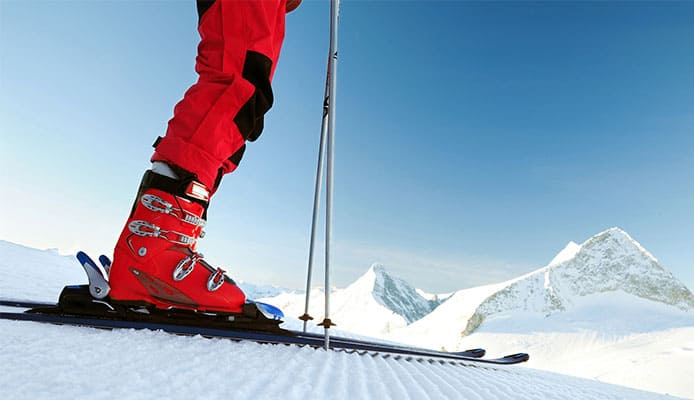
Q: Should My Toes Touch The Front Of The Boot?
To answer bluntly – no, your toes should not touch the front of the boot. There are precise steps that you should follow to ensure that the ski boot fits properly. Do this:
- Put the ski boot on
- Slam your heel back, either by pushing or just tapping the heel of the boot against a wall or the floor
- Push the tongue of the ski boot down
- Tighten all the bootstraps
- Stand up in an athletic stance and put pressure on the front of the foot
- Make sure your toes are not touching or sliding into the front of the boot
- Your heel should also not lift out of the heel pocket of the boot
That’s it! If you follow these steps precisely, it is almost guaranteed that you will get a well-fitting boot. Of course, there are some fine details that only professionals know, but this is a rough idea of how to get the sizing process started properly. By following these steps you will get around 80% of the ski boot size correctly.
Q: What Flex Boot Should I Wear?
Flex is not something that you should pick randomly. Instead, there are precise parameters that you should follow. The flex of the ski boot depends firstly on your skill level, then on other factors such as height, weight, and foot width. The better you are, the taller you are, and the heavier you are – the stiffer ski boot you will need. These factors all contribute to the choice of flex.
As a beginner or lower intermediate skier, you should go for softer flex ski boots – they are a lot more comfortable and more forgiving, whereas expert skiers and racers go for very stiff boots, which give the benefit of responsiveness and efficiency. Keep in mind that stiff ski boots lack the comfort and warmth found in ski boots for novices. For example, if you are a 5’10’’ man at 150 pounds, you should probably start somewhere around 80 – 90 flex. That will be great for learning, but by the time you become an advanced level skier, you should move in the 100+ range for most applications.
Related Review: Beginner Snowboard Boots
Low flex and comfort are recommended to beginners. Flex and ski boot fitting always go hand in hand to create a comfortable experience. Most beginners can get away with a heat-molded liner. So, if you are a beginner if you are a lightweight man try to start somewhere around 70. If you are a heavy man, try to start somewhere around 80. For women, the 60 – 80 flex range will do fine.
Q: My Boots Are Too Tight, What Should I Do?
It’s quite common to buy a pair of boots that just don’t fit quite perfectly as your normal day-to-day sneakers. Finding a perfect pair of boots out of the box is almost impossible. There are a couple of things you should do though. The most common areas for problems are the knuckle of the big doe and the ankles. These are areas of any ski boot that almost always have to be worked on for skiers to have a perfect, or comfortable fit.
Many professional shops where you buy your boots will do some work on the boots for free. You can also pay for this service and have your boots be “punched out” in an area causing you discomfort. This way, you will make your boots a lot more comfortable in any area you’d like. High-quality liners and shells can both be modified by a good boot tech to fit you just right. Manufacturers almost always recommend that you wear the boots for a few weeks to let them break in before you get any major changes done.
You will probably hear a lot of skiers say that “Your ski boot should be a little uncomfortable”. That might hold some truth to some extent. For beginners and intermediate skiers, there is no reason to have a painful or uncomfortable boot experience. If you are getting blisters, chafing, or painful areas, talk to a boot fitter or rental shop – they will probably help you. When you first start, expect your feet to take some time to adjust to the feeling of the ski boots. Don’t tolerate outright pain though.
Related Post: Ski Boot StretchingGlobo Surf Overview
Ultimately, your ski boots must fit comfortably, transfer power and movement to your skis, and create a stable platform on which to ski. All-day comfort is crucial. If you are having rubbing, pinching, hot spots, or irritation, take your boots to a ski shop and ask for customization. Ski boots can be easily modified by professionals. There are a ton of ski boot options available on the market.
As a beginner, consider the price of the ski boot and see how well it is suited for your feet and skill level. Stiff ski boots will make skiing a lot harder. Make sure to pick a pair of ski boots with a lower flex. If you are dedicated and you think you can progress quickly, get a ski boot you can improve with even after you become an intermediate skier. We believe that skiing is all about comfort and fun. If you read our guidelines you will certainly end up with a pair of the best beginner ski boots you can easily improve with. We hope that our buying guide will help you best the best ones for you!
More Snow Reviews:
- Ski Poles
- Ski Mid Layer
- Reeride Snowboard
- Cross Country Skis
- Ice Skates
- Snowmobile Gloves
- Avalanche Beacon
- Snowboard Bag
- Snowboard Wax
- Snow Tubes
More Boots Reviews:
- Backcountry Ski Boots
- Cross Country Ski Boots
- Freestyle Snowboard Boots
- Ski Boots For Kids
- Snowmobile Boots


